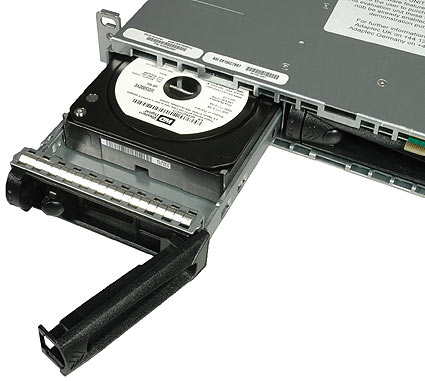iSCSI SANs Compared
Adaptec SnapServer 720i
As already mentioned, the SnapServer 700i family by Adaptec is a rack mount device which requires one height unit (1U). Currently there are four different versions: The SnapServer 720i family has 1 GB RAM and three Gigabit Ethernet ports, and is available with four 250 GB or 500 GB hard drives. The SnapServer 730i has four GbE ports, 2 GB RAM and four 750 GB hard drives. The top model, the SnapServer 750i, features four GbE ports and 2 GB RAM, but it uses four 300 GB SAS hard drives, which deliver slightly better performance than the other models’ SATA hard drives. All are based on a 2.6 GHz AMD Opteron processor; the 730i and 750i come with a redundant power supplies, which is optional for the entry-level versions.
The beauty of Adaptec’s concept is its scalability: the data sheet mentions a maximum capacity of 36 TB, which is really a lot of storage even for medium-sized businesses. This can be achieved by deploying multiples of Adaptec’s SANbloc S50 units, which are SAS/SATA 2U rack mount storage expansions for 12 drives. Using SAS drives, up to eight SANbloc S50 devices can be used to expand the capacity by 96 times 300 GB (which is the maximum SAS hard drive capacity available today), or 28.8 TB. With 750 GB SATA drives, you can reach a total capacity of 36 TB using four SANbloc S50 devices.
The SnapServer 700 series is covered by a front panel that includes a status display and status LEDs. The panel can be removed to provide access to the four hot-swap drive bays. Our test sample was a SnapServer 720i using four WD5000YS Caviar RAID Edition hard drives by Western Digital, each providing 500 GB capacity; the net capacity depends on the RAID configuration you select. One of the SnapServer’s three Gigabit Ethernet ports is dedicated to accessing the built-in configuration web service, but all ports can be used to run iSCSI.
Get Tom's Hardware's best news and in-depth reviews, straight to your inbox.
Current page: Adaptec SnapServer 720i
Prev Page How Does iSCSI Work? Next Page Inside The SnapServer 720i
Patrick Schmid was the editor-in-chief for Tom's Hardware from 2005 to 2006. He wrote numerous articles on a wide range of hardware topics, including storage, CPUs, and system builds.



